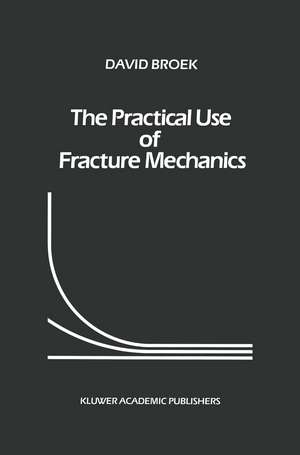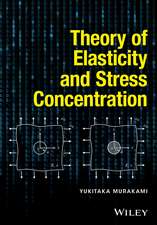The Practical Use of Fracture Mechanics
Autor D. Broeken Limba Engleză Hardback – 31 oct 1988
| Toate formatele și edițiile | Preț | Express |
|---|---|---|
| Paperback (1) | 628.38 lei 43-57 zile | |
| SPRINGER NETHERLANDS – 31 iul 1989 | 628.38 lei 43-57 zile | |
| Hardback (1) | 642.81 lei 43-57 zile | |
| SPRINGER NETHERLANDS – 31 oct 1988 | 642.81 lei 43-57 zile |
Preț: 642.81 lei
Preț vechi: 756.25 lei
-15% Nou
Puncte Express: 964
Preț estimativ în valută:
123.00€ • 128.75$ • 102.38£
123.00€ • 128.75$ • 102.38£
Carte tipărită la comandă
Livrare economică 31 martie-14 aprilie
Preluare comenzi: 021 569.72.76
Specificații
ISBN-13: 9789024737079
ISBN-10: 9024737079
Pagini: 540
Ilustrații: XIII, 522 p.
Dimensiuni: 210 x 297 x 34 mm
Greutate: 2.05 kg
Ediția:1989
Editura: SPRINGER NETHERLANDS
Colecția Springer
Locul publicării:Dordrecht, Netherlands
ISBN-10: 9024737079
Pagini: 540
Ilustrații: XIII, 522 p.
Dimensiuni: 210 x 297 x 34 mm
Greutate: 2.05 kg
Ediția:1989
Editura: SPRINGER NETHERLANDS
Colecția Springer
Locul publicării:Dordrecht, Netherlands
Public țintă
ResearchCuprins
1. Introduction.- 1.1. Fracture control.- 1.2. The two objectives of damage tolerance analysis.- 1.3. Crack growth and fracture.- 1.4. Damage tolerance and fracture mechanics.- 1.5. The need for analysis: purpose of this book.- 1.6. Exercises.- 2. Effects of Cracks and Notches: Collapse.- 2.1. Scope.- 2.2. An interrupted load path.- 2.3. Stress concentration factor.- 2.4. State of stress at a stress concentration.- 2.5. Yielding at a notch.- 2.6. Plastic collapse at a notch.- 2.7. Fracture at notches: brittle behavior.- 2.8. Measurement of collapse strength.- 2.9. Exercises.- 3. Linear Elastic Fracture Mechanics.- 3.1. Scope.- 3.2. Stress at a crack tip.- 3.3. General form of the stress intensity factor.- 3.4. Toughness.- 3.5. Plastic zone and stresses in plane stress and plane strain.- 3.6. Thickness dependence of toughness.- 3.7. Measurement of toughness.- 3.8. Competition with plastic collapse.- 3.9. The energy criterion.- 3.10. The energy release rate.- 3.11. The meaning of the energy criterion.- 3.12. The rise in fracture resistance: redefinition of toughness.- 3.13. Exercises.- 4. Elastic-Plastic Fracture Mechanics.- 4.1. Scope.- 4.2. The energy criterion for plastic fracture.- 4.3. The fracture criterion.- 4.4. The rising fracture energy.- 4.5. The residual strength diagram in EPFM: collapse.- 4.6. The measurement of the toughness in EPFM.- 4.7. The parameters of the stress-strain curve.- 4.8. The h-functions.- 4.9. Accuracy.- 4.10. Historical development of J.- 4.11. Limitations of EPFM.- 4.12. CTOD measurements.- 4.13. Exercises.- 5. Crack Growth Analysis Concepts.- 5.1. Scope.- 5.2. The concept underlying fatigue crack growth.- 5.3. Measurement of the rate function.- 5.4. Rate equations.- 5.5. Constant amplitude crack growth in a structure.- 5.6. Load interaction: Retardation.- 5.7. Retardation models.- 5.8. Crack growth analysis for variable amplitude loading.- 5.9. Parameters affecting fatigue crack growth rates.- 5.10. Stress corrosion cracking.- 5.11. Exercises.- 6. Load Spectra and Stress Histories.- 6.1. Scope.- 6.2. Types of stress histories.- 6.3. Obtaining load spectra.- 6.4. Exceedance diagram.- 6.5. Stress history generation.- 6.6. Clipping.- 6.7. Truncation.- 6.8. Manipulation of stress history.- 6.9. Environmental effects.- 6.10. Standard spectra.- 6.11. Exercises.- 7. Data Interpretation and Use.- 7.1. Scope.- 7.2. Plane strain fracture toughness.- 7.3. Plane stress and transitional toughness, R-curve.- 7.4. Toughness in terms of J and JR.- 7.5. Estimates of toughness.- 7.6. General remarks on fatigue rate data.- 7.7. Fitting the da/dN data.- 7.8. Dealing with scatter in rate data.- 7.9. Accounting for the environmental effect.- 7.10. Obtaining retardation parameters.- 7.11. Exercises.- 8. Geometry Factors.- 8.1. Scope.- 8.2. The reference stress.- 8.3. Compounding.- 8.4. Superposition.- 8.5. A simple method for asymmetric loading cases.- 8.6. Some easy guesses.- 8.7. Simple solutions for holes and stress concentrations.- 8.8. Simple solutions for irregular stress distributions.- 8.9. Finite element analysis.- 8.10. Simple solutions for crack arresters and multiple elements.- 8.11. Geometry factors for elastic-plastic fracture mechanics.- 8.12. Exercises.- 9. Special Subjects.- 9.1. Scope.- 9.2. Behavior of surface flaws and corner cracks.- 9.3. Break through: leak-before-break.- 9.4. Fracture arrest.- 9.5. Multiple elements, multiple cracks, changing geometry.- 9.6. Stop holes, cold worked holes and interference fasteners.- 9.7. Residual stresses in general.- 9.8. Other loading modes: mixed mode loading.- 9.9.Composites.- 9.10. Exercises.- 10. Analysis Procedures.- 10.1. Scope.- 10.2. Ingredients and critical locations.- 10.3. Critical locations and flaw assumptions.- 10.4. LEFM versus EPFM.- 10.5. Residual strength analysis.- 10.6. Use of R-curve and JR-curve.- 10.7. Crack growth analysis.- 10.8. Exercises.- 11. Fracture Control.- 11.1. Scope.- 11.2. Fracture control options.- 11.3. The probability of missing the crack.- 11.4. The physics and statistics of crack detection.- 11.5. Determining the inspection interval.- 11.6. Fracture control plans.- 11.7. Repairs.- 11.8. Statistical aspects.- 11.9. The cost of fracture and fracture control.- 11.10. Exercises.- 12. Damage Tolerance Substantiation.- 12.1. Scope.- 12.2. Objectives.- 12.3. Analysis and damage tolerance substantiation.- 12.4. Options to improve damage tolerance.- 12.5. Aircraft damage tolerance requirements.- 12.6. Other requirements.- 12.7. Flaw assumptions.- 12.8. Sources of error and safety factors.- 12.9. Misconceptions.- 12.10. Outlook.- 12.11. Exercises.- 13. After the Fact: Fracture Mechanics and Failure Analysis.- 13.1. Scope.- 13.2. The cause of service fractures.- 13.3. Fractography.- 13.4. Features of use in fracture mechanics analysis.- 13.5. Use of fracture mechanics.- 13.6. Possible actions based on failure analysis.- 13.7. Exercises.- 14. Applications.- 14.1. Scope.- 14.2. Storage tank (fictitious example).- 14.3. Fracture arrest in ships.- 14.4. Piping in chemical plant (fictitious example).- 14.5. Fatigue cracks in railroad rails.- 14.6. Underwater pipeline.- 14.7. Closure.- 15. Solutions To Exercises.








